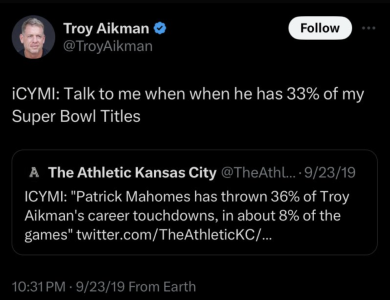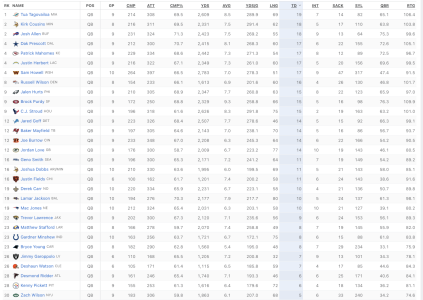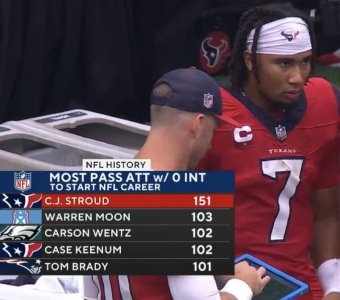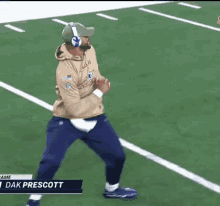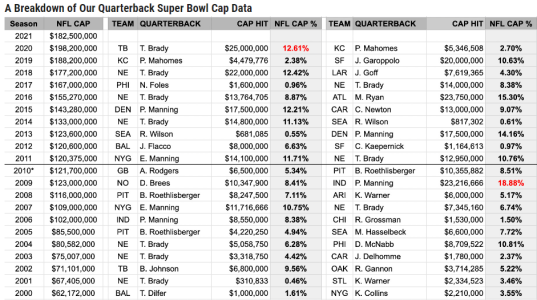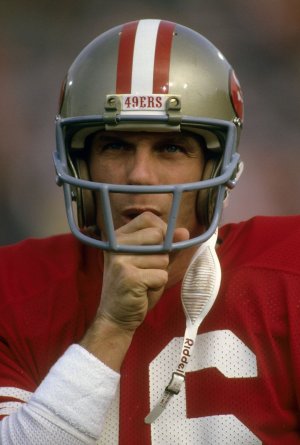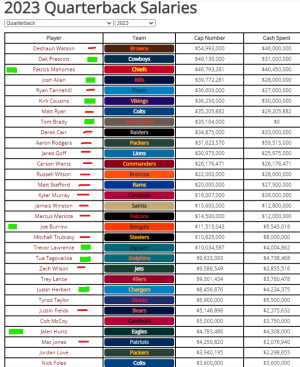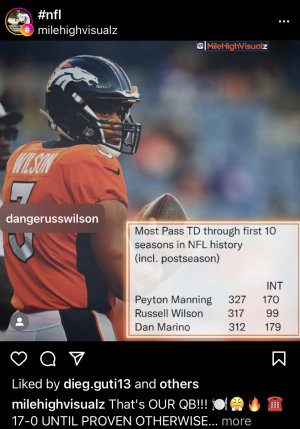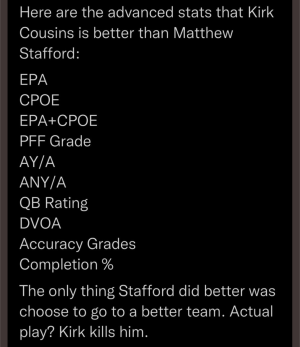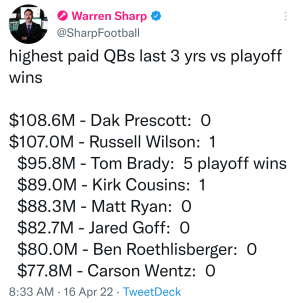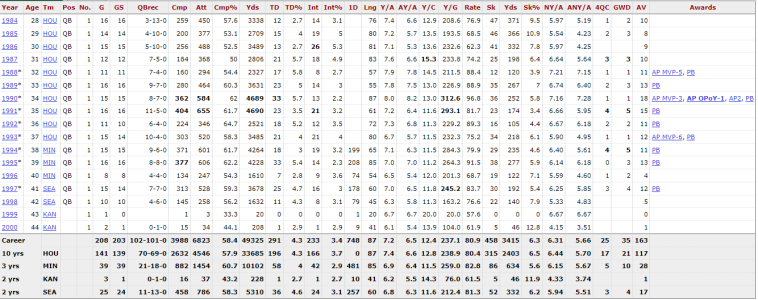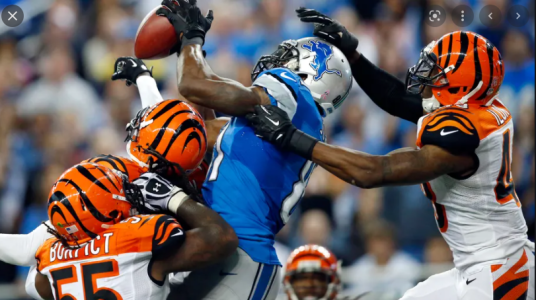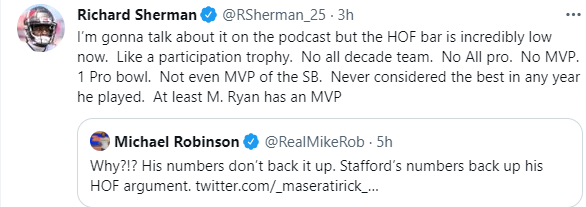In 2008, NFL Films debuted a special entitled, "Top 10 Records That Won't Be Broken." The No. 2 choice? Johnny Unitas' streak of 47 consecutive games with a touchdown pass.
The record, which had stood for 48 years, was placed on par with Joe DiMaggio's 56-game hitting streak in baseball. The closest anyone had come to Unitas' mark was Brett Favre's run of 36 games, which ended in 2004. In an era of increased injuries and ubiquitous parity, it seemed safe forever.
In 2012, four years after the NFL Films special, Drew Brees blew by Unitas and pushed the record to 54 games.
One year after that, Tom Brady made it to 52.
And earlier this season, Peyton Manning's streak ended at 51.
View media item 1309584
Records are meant to be broken, of course. But they should also provide structure for comparing different eras, a task rendered nearly impossible by the NFL's most recent passing explosion. Effectively, we're in the midst of the NFL's "Steroids Era," a time when an above-average performance exceeds the best in history and an elite one obliterates it.
Baseball's "funnyball" presumably originated in unregulated drug enhancements. In football, the working theory is less sinister but just as powerful: A systematic shift in rules and schemes has forced us to alter our definitions of bad, good and great.
Consider that in 1979, Hall of Fame quarterback Roger Staubach retired with an 83.4 passer rating. At the time, it was an NFL record. In 2001, fellow Hall of Famer Troy Aikman retired with an 81.6 rating. Naturally, current Tampa Bay Buccaneers backup Mike Glennon tops them both with an 83.7 career mark.
Last month, journeyman Ryan Fitzpatrick threw six touchdown passes in a game for the Houston Texans. Fourteen of the 23 modern-day Hall of Fame quarterbacks -- including Staubach, Unitas and Terry Bradshaw, along with more recent inductees such as Aikman, John Elway and Steve Young -- never did that in a regular-season game. (Young did accomplish the feat in Super Bowl XXIX.)
"I've always thought it's like comparing apples and oranges anyway, even in the same era," Elway said. "But I think even more so now it's tougher because of the offenses that are wide open -- spread offenses and hurry-up offenses."
Dan Daly, a football historian who maintains the site ProFootballDaly.com, has long argued for a fundamental change to statistical warehousing. "You need to calibrate it by decade or maybe even by year," Daly said. "It would basically be football grade inflation. Otherwise, it makes no sense."
Daly has written two books on pro football history, and he could add another on this topic alone. For now, here's a quick overview of how the league's evolution changed the QB math overnight.
'Interception avoidance'
Joe Namath retired in 1977 and was inducted to the Hall of Fame in 1985 after throwing 50 more interceptions (220) than touchdown passes (170) in his career. It's safe to say no current quarterback would keep his job throwing 1.6 interceptions per game. (Just ask Jay Cutler, the NFL's interception leader at 1.3 per game in 2014.)
Eli Manning leads the league with 120 interceptions over the past seven years. His per-game average over that span (1.1) comes nowhere close to Namath's.
But even Manning, the most mistake-prone QB of the current era, has thrown 58 more touchdown passes than interceptions during that span.
And then there's this: Manning's passer rating from 2008 to 2014 comes in at 86.3. Namath's career mark: 65.5.
"So much of the game now is just interception avoidance," Daly said. "If you don't throw an interception, you don't have to do anything else well to get a halfway decent rating. Because of the rule changes we've seen and the way the game is being played ... you've had an elimination of a lot of risk in throwing the ball. So the passer rating goes up, but that doesn't necessarily reflect better performance."
Dan Marino, who retired after the 1999 season, threw 252 interceptions in 8,358 attempts (3 percent) over 17 seasons. Aaron Rodgers has thrown 56 interceptions over 3,354 attempts (1.7 percent) since he became the starter seven seasons ago.
At his current rate, Rodgers would have to play 22 more years to match Marino's interception total.
The NFL record for career interceptions has stood for 35 years. Paul Krause had 81 when he retired in 1979, and the closest active player is 38-year-old Charles Woodson -- at 59! If you're looking for a potential challenger to Krause's record, you'll be searching for a while. There isn't a single active player younger than 30 years old who ranks among the 277 highest totals in career interceptions.
Back to the AFL
During the first century of pro football, one player produced a 5,000-yard passing season: Marino (5,084 yards) in 1984. Since the start of 2008, it's happened seven times. Brees was responsible for four of those, and Peyton Manning, Brady and Matthew Stafford had one 5,000-yard season apiece.
Indeed, figures that used to be mind-numbing are becoming commonplace to contemporary fans, who long ago understood the NFL's reasons for favoring pass offense: entertainment and attention. What's notable is that it isn't the first time pro football has followed this path.
View media item 1309583
Daly has written extensively about the early years of the American Football League in the 1960s, before its 1970 merger with the NFL.
"With pretty much any new league in history," Daly said, "there has been a shared opinion that if you want to sell yourself, you do it by being an offensive league. The old AFL had Sid Gillman, who was a revolutionary in the passing game. Al Davis was a downfield-passing guy. Sammy Baugh liked to throw it downfield."
Here's a fun fact you might not realize: In 1961, George Blanda threw 36 touchdown passes in 14 games for the Houston Oilers, including seven in one contest, a feat that was matched twice in the 2013 season alone (by Peyton Manning and Nick Foles). The AFL's passing numbers regressed a bit as the league gained on the NFL's popularity prior to the merger, but its original splash helped it rise from obscurity.
Viewed from a historical perspective, it could be argued that the NFL has utilized a proven method to elevate its popularity to new heights since 2008.
Consider this: In 168 career games from 1970 to 1983, Bradshaw threw for 300 yards four times. Andrew Luck has done it 10 times this season. Luck is on pace to produce the NFL's eighth 5,000-yard passing year since the start of 2008.
Today's unbreakable record
In 1958, Unitas threw an astounding 32 touchdown passes in a 12-game season, which prorates to almost 43 TDs over today's 16-game slate. Five years later, Unitas threw for 3,481 yards in a 14-game season -- nearly 4,000 in the context of 16 games.
Those figures might not look like much now, but they were huge outliers in an era dominated by the running game. Unitas' touchdown total in 1958 was twice the NFL average, and his 1963 yardage was about 35 percent higher than average.
View media item 1309581
"With the new rules," Elway said, "when I look at the numbers, truly the unbelievable numbers are Johnny Unitas' numbers. ... The numbers he was able to put up in the old rules, which favored the running game, were tremendous."
In the current era, it's fair to wonder whether the reverse is true. The NFL's most unbreakable record, Daly suggests, might be Emmitt Smith's mark of 18,355 career rushing yards. (It was not among the 10 considered by NFL Films in 2008.)
The closest active player to Smith is Steven Jackson, who ranks No. 16 at 11,379 yards and is in on pace for his second consecutive sub-1,000-yard season. Is there any reason to think Jackson has 7,000 more yards in him at age 31? Adrian Peterson once seemed a legitimate candidate to threaten Smith's record, but after a lost season in 2014, he'll need to rush for 8,165 yards after his 30th birthday to get there.
Capacity is only part of the argument, of course. Why would any team in this era employ a run-heavy scheme, given all the advantages of the passing game? After all, Josh McCown (Josh McCown!) has completed 60.9 percent of his passes since 2008, higher than the career average of every Hall of Fame quarterback except Steve Young (64.3), Joe Montana (63.2) and Troy Aikman (61.5). What would you do?








 Enjoy!
Enjoy!










